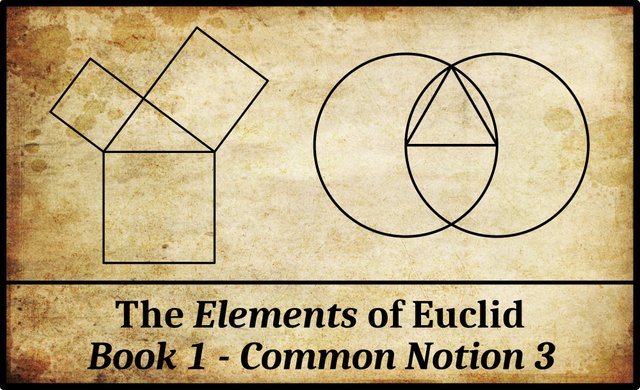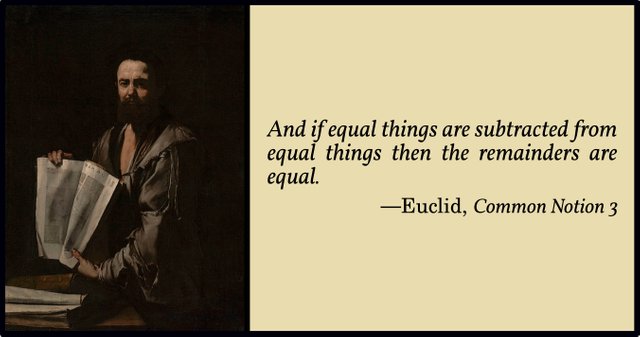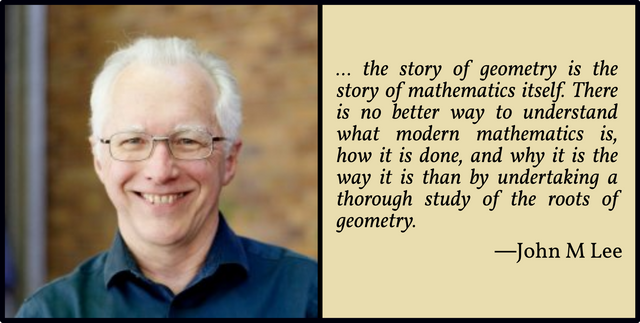
In Book 1 of Euclid’s Elements, the third of the Five Common Notions reads (Fitzpatrick 7):
| Greek | English |
|---|---|
| γʹ. Καὶ ἐὰν ἀπὸ ἴσων ἴσα ἀφαιρεθῇ, τὰ καταλειπόμενά ἐστιν ἴσα. | 3. And if equal things are subtracted from equal things then the remainders are equal. |
This is obviously the counterpart of Common Notion 2, in which equal things were added to equal things. Like its counterpart, it was regarded as genuine by early commentators on the Elements, such as Proclus Lycius and Heron of Alexandria (Heath 223).
Clearly, Euclid’s geometric operation of subtracting things is to be understood in the same way as his operation of adding things. Euclid’s verb, ἀφαιρεθῇ [aphairethēi], is the aorist passive subjunctive form of the verb ἀφαιρέω [aphaireō]. This is the usual word used in Ancient Greek for mathematical subtraction. Henry Liddell & Robert Scott do not explicitly state this in A Greek-English Lexicon (Liddell & Scott 257), but this meaning is given in Henry Stuart Jones’ New Edition of the Lexicon, which was published in 1940 (Jones 285).
Euclid uses the third person singular form of the verb because the subject ἴσα [isa], things, is neuter plural:
958 A neuter plural subject is regarded as a collective (996), and has its verb in the singular. (Weir 264)
See the preceding article in this series for a discussion of how Euclid adds—and, by implication, subtracts—things in the geometric sense of the word.

In his book Axiomatic Geometry, John M Lee, Professor Emeritus of Mathematics at the University of Washington, sums up the matter thus:
Whereas the five postulates express facts about geometric configurations, the common notions express facts about magnitudes. For Euclid, magnitudes are objects that can be compared, added, and subtracted, provided they are of the “same kind.” In Book I, the kinds of magnitudes that Euclid considers are (lengths of) line segments, (measures of) angles, and (areas of) triangles and quadrilaterals. For example, a line segment (which Euclid calls a “finite straight line”) can be equal to, greater than, or less than another line segment; two line segments can be added together to form a longer line segment; and a shorter line segment can be subtracted from a longer one. ( 5)
It is interesting to observe that although Euclid compares, adds, and subtracts geometric magnitudes of the same kind, he never uses numbers to measure geometric magnitudes. This might strike one as curious, because human societies had been using numbers to measure things since prehistoric times. But there is a simple explanation for its omission from Euclid’s axiomatic treatment of geometry: to the ancient Greeks, numbers meant whole numbers, or at best ratios of whole numbers (what we now call rational numbers). However, the followers of Pythagoras had discovered long before Euclid that the relationship between the diagonal of a square and its side length cannot be expressed as a ratio of whole numbers. In modern terms, we would say that the ratio of the length of the diagonal of a square to its side length is equal to √2; but there is no rational number whose square is 2 ...
This fact had the consequence that, for the Greeks, there was no “number” that could represent the length of the diagonal of a square whose sides have length 1. Thus it was not possible to assign a numeric length to every line segment.
Euclid’s way around this difficulty was simply to avoid using numbers to measure magnitudes. Instead, he only compares, adds, and subtracts magnitudes of the same kind. (Lee 5)
The only emendation I would make to this is to remove Lee’s qualification for the Greeks. There is no number that measures incommensurable magnitudes—period. Lee and many of his contemporaries believe that real irrational numbers do just this, but I agree with mathematicians like Norman J Wildberger and John Gabriel, who dispute this belief.

Other Common Notions
In his translation of the Elements Richard Fitzpatrick adds the following footnote to this Common Notion:
As an obvious extension of C.N.s 2 & 3—if equal things are added or subtracted from the two sides of an inequality then the inequality remains an inequality of the same type. (Fitzpatrick 7-8)
As we saw in an earlier article, some editions of the Elements explicitly include something of this nature among the Common Notions. For example, François Peyrard’s edition of 1814 lists nine Common Notions, the fifth of which reads:
| Greek | English |
|---|---|
| εʹ. Καὶ ἐὰν ἀπὸ ἀνίσων ἴσα ἀφαιρεϑῇ, τὰ λοιπά ἐστιν ἄνισα. | And if from unequal things equal things are subtracted then the remainders are unequal. |
Henry Billingsley’s English translation of the Elements includes both forms:
4 And if from unequall thinges ye take away equall thinges : the thynges which remayne shall be unequal ...
5 And if to unequall thinges ye adde equall thinges : the whole shall be unequal. (Billingsley Fol 7)
Proclus also includes both in his Commentary on the First Book of Euclid’s Elements—at least, he does in the translations by Barocius and Thomas Taylor, though these are based on inferior manuscripts (Morrow 158 fn 23, xliv : Barozzi 111 : Taylor 12).

Explicit Use in the Elements
Euclid only uses this Common Notion explicitly on a handful of occasions in Book 1. The three commentators on the Elements whose work I have consulted for this article—Richard Fitzpatrick, Thomas Heath, and David Joyce—only cite it explicitly in the following propositions:
- Fitzpatrick 1:2, 1:5, 1:14, 1:15.
- Heath 1:2, 1:14, 1:15, 1:35, 1.43
- Joyce 1:2, 1:5, 1:14, 1:15, 1:28, 1:35, 1:43
Of course many later propositions build upon those of Book 1, so this Common Notion is often implied in their proofs.
And that’s a good place to stop.
References
- Ernst Ferdinand August, Euclidis Elementa, Part 1, Theodor Trautwein, Berlin (1826)
- Francesco Barozzi, Procli Diadochi Lycii in Primum Euclidis Elementorum Commentariorum Libri IV, Grazioso Percacino, Padua (1560)
- Henry Billingsley (translator), The Elements of Geometrie of the Most Auncient Philosopher Evclide of Megara, John Day, London (1582)
- Richard Fitzpatrick (translator), Euclid’s Elements of Geometry, University of Texas at Austin, Austin, TX (2008)
- David Gregory (editor), Ευκλειδου Τα Σωζομενα : Euclidis Quae Supersunt Omnia [The Extant Works of Euclid], Oxford (1703)
- Thomas Little Heath (translator & editor), The Thirteen Books of Euclid’s Elements, Second Edition, Dover Publications, New York (1956)
- Johan Ludvig Heiberg, Heinrich Menge, Euclidis Elementa edidit et Latine interpretatus est I. L. Heiberg, Volumes 1-5, B G Teubner Verlag, Leipzig (1883-1888)
- Henry Stuart Jones (editor), A Greek-English Lexicon, A New Edition, Revised and Augmented Throughout, Volume 1, Oxford, At the Clarendon Press (1940)
- John M Lee, Axiomatic Geometry, American Mathematical Society, Providence, Rhode Island (2013)
- Henry George Liddell, Robert Scott, A Greek-English Lexicon, Eighth Edition, American Book Company, New York (1901)
- Glenn Raymond Morrow (translator), Proclus: A Commentary on the First Book of Euclid’s Elements, Princeton University Press, Princeton, NJ (1970)
- François Peyrard, Les Œuvres d’Euclide, en Grec, en Latin et en Français, Volumes 1-3, Charles-Frobert Patris, Paris (1814, 1816, 1818)
- Herbert Weir Smyth, A Greek Grammar for Colleges, American Book Company, New York (1920)
- Thomas Taylor, The Philosophical and Mathematical Commentaries of Proclus on the First Book of Euclid’s Elements, Volume 1, Volume 2, London (1792)
Image Credits
- Euclid: Common Notion 3: Jusepe di Ribera (artist), Getty Center, Los Angeles, Public Domain
- John M Lee: © University of Washington, Fair Use
- Francesco Barozzi: Lodovico Vedriani, Dottori Modonesi di teologia, filosophia, legge canonica e civile, Page 264, Andrea Cassiani, Modena (1665), Public Domain
- Thomas Taylor: Thomas Lawrence (artist), National Gallery of Canada, Ottawa, Public Domain
Online Resources
